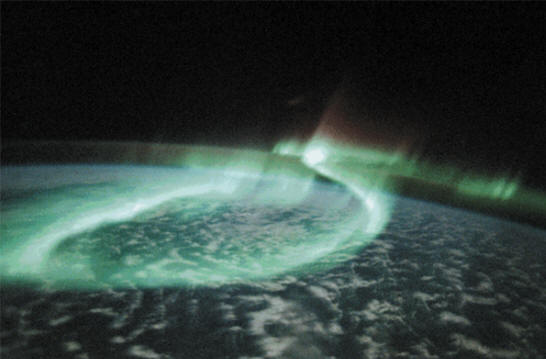|

The southern auroral oval. Image from the Space
Shuttle Discovery. Credit: NASA, Astronaut
Overmeyer and Dr. Hallinan.
Hyperion's Daughter
Jun
04, 2010
Electrons streaming into Earth's
magnetosphere energize the bands of
colored light at each pole.
Then, rising with Aurora's light,
The Muse invoked, sit down to write;
Blot out, correct, insert, refine,
Enlarge, diminish, interline.
--- Jonathan Swift
On July 16 and then again on
August 9, 2000, the European Space
Agency (ESA) launched a small
squadron of four spacecraft called
Cluster II
from the
Baikanor Cosmodrome in
Kazakhstan. The individual
satellites were given the names
Rumba, Salsa, Samba, and Tango.
The Cluster II spacecraft were
originally scheduled to spend two
years investigating the interaction
between the Sun and our own world.
However, ESA extended the mission
until 2009 and then again until
2012. The four probes were designed
to explore the layers and boundaries
that exist within Earth's
magnetosphere, as well as monitor
the magnetic poles and the
magnetotail. They constantly cross
the intersection that delineates
Earth's magnetic bubble from the
solar wind.
Discovering the interaction
between the solar wind and the
magnetosphere is Cluster's primary
goal. The identical spacecraft are
flying a tetrahedral formation in a
highly elliptical orbit. Cluster is
currently collecting information
about how charged particles from the
Sun enter the Earth's atmosphere
through magnetic "funnels" at each
pole.
Earth's complex, electrically
active magnetotail (or plasma tail)
extends for millions of kilometers,
always pointing away from the Sun.
The solar wind is captured by the
magnetosphere, and along with ions
ejected by the Earth, collects in a
plasma sheet within the magnetotail
that is held together by our
planet's magnetic field.
Between 1902 and 1903, Kristian
Birkeland's
Norwegian Aurora Polaris
Expedition found electric
currents from the Aurora Borealis
flowing parallel to the
polychromatic displays. Since
electric currents must complete a
circuit, and because the aurora
seemed to be influenced by energetic
events beyond the atmosphere, he
wrote that those currents probably
flow down from space at one end of
the auroral arc and back out to
space at the other.
Toroids of charged particles,
otherwise known as "plasma,"
surround Earth, confined by its
magnetic field. They are commonly
called "Van Allen radiation belts"
after Dr. James Van Allen, whose
Explorer I and Explorer 3
missions confirmed Birkeland's
theoretical conclusions. Similar
structures exist around other
planets.
Plasma contains charged
particles. They can be negatively
charged electrons, positively
charged ions, or dust particles that
have an excess of either positive or
negative charge. Neon signs are
plasma. Lightning is plasma. Earth’s
magnetosphere, the solar wind, and
the
Sun itself are plasma.
Nebulae in space,
referred to most often as "hot gas
and dust," are plasma. Dark
interstellar clouds, mostly composed
of hydrogen, are plasma because they
exhibit magnetic fields and radiate
in radio wavelengths.
Solar ions travel along Earth's
magnetic field into the poles,
causing atmospheric molecules to
emit light: red from oxygen at high
altitudes, green from oxygen lower
down, and blue from nitrogen. Strong
electromagnetic disturbances are
observed when a bright aurora is
seen.
Recently,
ESA announced that
Cluster has successfully measured
the acceleration of ions as they
enter Earth's environment. Although
ESA mission specialists speculate
that the aurora are created by
so-called "magnetic reconnection"
phenomena,
previous Picture of the
Day articles have demonstrated why
that explanation is incorrect.
Conventional theories state that
Earth's magnetosphere deforms like a
teardrop because it is bombarded by
the Sun's solar wind. The field is
compressed on the sunward side and
stretched on the dark side. Magnetic
field lines are said to "flap like a
flag waving in the wind."
When magnetic field lines cross
and "reconnect" (through an
unexplained mechanism), they are
said to "detonate" with bursts of
heat, light and electricity. The
power from those "magnetic
explosions" is thought to flow down
into Earth's poles, energizing
auroral colors.
Magnetic field lines cannot
stretch, compress, or flap because
they are no more "real" than lines
of latitude and longitude: they are
character symbols. A circuit
schematic is no more a circuit board
than magnetic field lines are a
magnetic field. To say that magnetic
field lines can cross, or flap, or
break and reconnect is tantamount to
saying that weather diagrams can
produce rain.
"The knowledge gained since 1896,
in radioactivity has favoured the
view to which I gave expression in
that year, namely, that magnetic
disturbances on the earth, and
aurora borealis, are due to
corpuscular rays emitted by the
Sun."
--- Kristian Birkeland "The
Norwegian Aurora Polaris Expedition
1902-1903, Volume 1, Part 1"
Stephen Smith
Hat tip to James Parker
|







